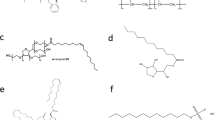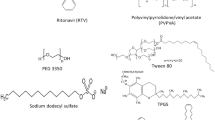ABSTRACT
Purpose
To evaluate the role of polymer-surfactant interactions in drug solubilisation/stabilisation during the dissolution of spray-dried solid dispersions and their potential impact on in vivo drug solubilisation and absorption.
Methods
Dissolution/precipitation tests were performed on spray-dried HPMC-Etravirine solid dispersions to demonstrate the impact of different surfactants on the in vitro performance of the solid dispersions. Interactions between HPMC and bio-relevant and model anionic surfactants (bile salts and SDS respectively) were further characterised using surface tension measurements, fluorescence spectroscopy, DLS and SANS.
Results
Fast and complete dissolution was observed in media containing anionic surfactants with no drug recrystallisation within 4 h. The CMCs of bile salts and SDS were dramatically reduced to lower CACs in the presence of HPMC and Etravirine. The maximum increases of the apparent solubility of Etravirine were with the presence of HPMC and SDS/bile salts. The SANS and DLS results indicated the formation of HPMC-SDS/bile salts complexes which encapsulated/solubilised the drug.
Conclusions
This study has demonstrated the impact HPMC-anionic surfactant interactions have during the dissolution of non-ionic hydrophilic polymer based solid dispersions and has highlighted the potential relevance of this to a fuller understanding of drug solubilisation/stabilisation in vivo.







Similar content being viewed by others
REFERENCES
Serajuddin ATM. Solid dispersion of poorly water-soluble drugs: early promises, subsequent problems, and recent breakthroughs. J Pharm Sci. 1999;88(10):1058–66.
Leuner C, Dressman J. Improving drug solubility for oral delivery using solid dispersions. Eur J Pharm Biopharm. 2000;50:47–60.
Sheen PC, Khetarpal VK, Cariola CM, Rowlings CE. Formulation studies of a poorly water-soluble drug in solid dispersions to improve bioavailability. Int J Pharm. 1995;118:221–7.
Craig DQM. The mechanisms of drug release from solid dispersions in water-soluble polymers. Int J Pharm. 2002;231:131–44.
Lakshman JP, Cao Y, Kowalski J, Serajuddin ATM. Application of melt extrusion in the development of a physically and chemically stable high-energy amorphous solid dispersion of a poorly water-soluble drug. Mol Pharm. 2008;5(6):994–1002.
Qi S, Marchaud D, Craig DQM. An investigation into the mechanism of dissolution rate enhancement of poorly water-soluble drugs from spray chilled Gelucire 50/13 microspheres. J Pharm Sci. 2010;99(1):262–74.
Brouwers J, Brewster ME, Augustijns P. Supersaturating drug delivery systems: the answer to solubility-limited oral bioavailability? J Pharm Sci. 2009;98(8):2549–72.
Gao P, Rush RD, Pfund WP, Huang T, Bauer JM, Morozowich W, et al. Development of a supersaturable SEDDS (SSEDDS) formulation of paclitaxel with improved oral bioavailability. J Pharm Sci. 2003;92(12):2395–407.
Pellett MA, Castellano S, Hadgraft J, Davis AF. The penetration of supersaturated solutions of piroxicam across silicone membranes and human skin in vitro. J Control Rel. 1997;46:205–14.
Iervolino M, Cappello B, Raghavan SL, Hadgraft J. Penetration enhancement of ibuprofen from supersaturated solutions through human skin. Int J Pharm. 2001;212:131–41.
Vardakou M, Mercuri A, Barker SA, Craig DQM, Faulks RM, Wickham MSJ. Achieving antral grinding forces in biorelevant in vitro models: comparing the USP Dissolution Apparatus II and the Dynamic Gastric Model with human in vivo data. AAPS PharmSciTech. 2011;12(2):620–6.
Mercuri A, Passalacqua A, Wickham MSJ, Faulks RM, Craig DQM, Barker SA. The effect of composition and gastric conditions on the self-emulsification process of ibuprofen-loaded self-emulsifying drug delivery systems: a microscopic and dynamic gastric model study. Pharm Res. 2011;28:1540–51.
McConnell EL, Fadda HM, Basit AW. Gut instincts: explorations in intestinal physiology and drug delivery. Int J Pharm. 2008;364:213–26.
Madenci D, Egelhaaf SU. Self-assembly in aqueous bile salt solutions. Curr Opinion Colloid Interface Sci. 2010;15:109–15.
Cabane B, Duplessix R. Decoration of semidilute polymer solutions with surfactant micelles. J Phys (Paris). 1987;48:651–62.
Bury R, Desmazieres B, Treiner C. Interactions between poly(vinylpyrrolidone) and ionic surfactants at various solid/water interfaces: a calorimetric investigation. Colloids Surf A. 1997;127:113–24.
Löfroth JE, Johansson L, Norman AC, Wettström K. Interactions between surfactants and polymers. I: HPMC. Progr Colloid Polym Sci. 1991;84:73–7.
Holmberg C, Nilsson S, Sundelöf LO. Thermodynamic properties of surfactant/polymer/water systems with respect to clustering adsorption and intermolecular interaction as a function of temperature and polymer concentration. Langmuir. 1997;13(6):1392–9.
Nilsson S. Interactions between water-soluble cellulose derivatives and surfactants. 1. The HPMC/SDS/Water system. Macromolecules. 1995;28(23):7837–44.
Nilsson S, Sundelöf LO, Porsch B. On the characterization principles of some technically important water soluble non-ionic cellulose derivatives. Carbohydrate Polymers. 1995;28:265–75.
Persson B, Nilsson S, Sundelöf LO. On the characterization principles of some technically important water soluble non-ionic cellulose derivatives. Part II: Surface tension and interaction with a surfactant. Carbohydrate Polymers. 1996;29:119–27.
Couderc S, Li Y, Bloor DM, Holzwarth JF, Wyn-Jones E. Interaction between the nonionic surfactant hexaethylene glycol mono-n-dodecyl ether (C12EO6) and the surface active nonionic ABA block copolymer pluronic F127 (EO97PO69EO97) formation of mixed micelles studied using isothermal titration calorimetry and differential scanning calorimetry. Langmuir. 2001;17:4818–24.
Li Y, Ghoreishi SM, Warr J, Bloor DM, Holzwarth JF. Interactions between a nonionic copolymer containing different amounts of covalently bonded vinyl acrylic acid and surfactants: EMF and microcalorimetry studies. Langmuir. 1999;15:6326–32.
Li Y, Bloor DM, Penfold J, Holzwarth JF, Wyn-Jones E. Moderation of the interactions between sodium dodecyl sulfate and poly(vinylpyrrolidone) using the nonionic surfactant hexaethyleneglycol mono-n-dodecyl ether C12EO6: an electromotive force, microcalorimetry, and small-angle neutron scattering study. Langmuir. 2000;16:8677–84.
Purcell IP, Lu JR, Thomas RK, Howe AM, Penfold J. Adsorption of sodium dodecyl sulfate at the surface of aqueous solutions of poly(vinylpyrrolidone) studied by neutron reflection. Langmuir. 1998;14:1637–45.
Lu JR, Thomas RK, Penfold J. Surfactant layers at the air/water interface: structure and composition. Adv Colloid Interface Sci. 2000;84:143–304.
Rowe RC, Sheskey PJ, Owen SC. Handbook of pharmaceutical excipients. 5th ed. Washington DC: American Pharmaceutical Assocaition (AphA) Publications; 2005. p. 272.
Voorspoels J. R165335-F060-100mg tablet-formulation development. Technical Report PD-TECH-R165335-F060, Johnson& Johnsom Pharmaceutical Research & Development. 27th Feb 2005.
Weuts I, Dycke FV, Voorspoels J, Cort SD, Stokbroekx S, Leemans R, et al. Physicochemical properties of the amorphous drug, cast films and spray dried powders to predict formulation probability of success for solid dispersions: etravirine. J Pharm Sci. 2011;100(1):260–74.
Dissolution test method, Johnson & Johnson Pharmaceutical Research & Development, internal report AD-TM-R165335-F060-TAB-DL-001172-v2.3, 08 Feb 2007
Aguiar J, Carpena P, Molina-Bolivar JA, Carnero Ruiz C. On the determination of the critical micelle concentration by the pyrene 1:3 ratio method. J Coll Int Sci. 2003;258:116–22.
Heenan RK, Penfold J, King SM. SANS at pulsed neutron sources: present and future prospects. J Appl Cryst. 1997;30:1140–7.
Kline SR. Reduction and analysis of SANS and USANS data using Igor pro. J Appl Cryst. 2006;39(6):895–900.
Umlong IM, Ismail K. Micellization behaviour of sodium dodecyl sulfate in different electrolyte media. Colloids Surf A. 2007;299:8–14.
ACKNOWLEDGMENTS AND DISCLOSURES
The authors would like to acknowledge STFC for provision of neutron beamtime and Drs Stephen King and Sarah Rogers for their technical support and the financial support from Pharmaceutical Research and Development, Johnson & Johnson, Belgium. The authors would also like to thank Prof. Duncan, Q.M. Craig, Jody Voorspoels, Marcus Brewster for their constructive discussion, and Dr Francesca Baldelli Bombelli from the University of East Anglia for her assistance on DLS data processing.
Author information
Authors and Affiliations
Corresponding author
Electronis supplementary material
Below is the link to the electronic supplementary material.
ESM 1
(DOC 326 kb)
Rights and permissions
About this article
Cite this article
Qi, S., Roser, S., Edler, K.J. et al. Insights into the Role of Polymer-Surfactant Complexes in Drug Solubilisation/Stabilisation During Drug Release from Solid Dispersions. Pharm Res 30, 290–302 (2013). https://doi.org/10.1007/s11095-012-0873-7
Received:
Accepted:
Published:
Issue Date:
DOI: https://doi.org/10.1007/s11095-012-0873-7




